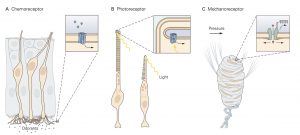1
Learning objective 1: To know the general properties of sensory receptors
Sensory receptors are specialized, excitable cells that are designed to convert a physical stimulus in the external world (e.g., light, sounds, odors, etc.) or one that occurs inside our bodies (e.g., blood pressure, muscle force, osmolality, etc.) into an electrical signal that can be transmitted to other nerve cells in the nervous system. In all cases, the physical stimulus interacts with a specialized receptor protein embedded in the membrane of the sensory receptor leading to a change in membrane potential. The receptor proteins in sensory receptors typically respond to only one type of stimulus that confers selectivity and specificity to the receptor. For example, the receptor protein in a cutaneous mechanoreceptor responds to the mechanical deformation of its membrane, whereas the receptor protein of a rod or cone photoreceptor in the retina responds to light energy. The form of energy that a receptor preferentially responds to is called the ‘adequate stimulus’.

Sensory receptors can be grouped into one of three classes: free nerve endings, nerve endings surrounded by accessory structures, and specialized sensory receptor cells . For free nerve ending receptors, the stimulus interacts directly with the receptor proteins in the sensory receptor’s membrane causing a localized depolarization called a receptor potential. This depolarization spreads electronically along the sensory receptor’s axon where it encounters voltage-gated sodium and potassium channels that generate action potentials. The action potentials are propagated along the axon until they reach the central terminals of the sensory neuron within the central nervous system (CNS) where they initiate the release of neurotransmitters at synapses that excite other nerve cells, called secondary sensory neurons. These secondary sensory neurons carry the signal from the sensory receptors to various regions of the CNS.
The sequence of events described above is the same for sensory receptors with accessory structures except that the stimulus interacts directly with the accessory structure rather than the receptor proteins directly. The accessory structure shapes or filters the original stimulus before in engages with the receptor proteins. For example, the cornea and lens of the eye are accessory structures that serve to focus incident light that enters the pupil onto the rod and cone sensory receptors in the retina located at the back of the eye. The third class of sensory receptors, specialized receptor cells, lacks an axon and thus, do not generate action potentials. When specialized receptor cells interact with their adequate stimulus, a change in membrane potential occurs which leads to either an increase or a decrease in the amount of neurotransmitter that they release onto post-synaptic sensory nerve cells.
